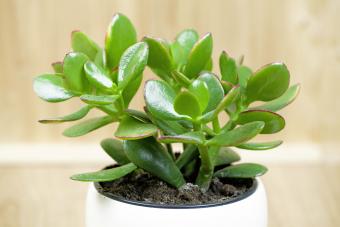
Raise your hand if you ever accidentally drowned a plant. Guilty! We know your intentions were good, but plants have different water needs, and many need good drainage or their roots rot. But these plants? They don't require any drainage to speak of. As long as you don't overwater them, they'll stay healthy and be easy to grow. These plants make great houseplants, deck plants, and hanging plants.
1. Coleus

Coleus (Coleus scutellarioides) is a popular border or container plant. It's evergreen, although there are several varieties that feature different colors and color combinations for a true showcase foliage. It prefers bright, indirect sunlight. You don't want to over-water. The plant stems are semi-succulent, so the soil should be kept moist, but not soggy. The plant produces tiny purple-blue flowers.
2. Dumb Cane

Dieffenbachia is also known as dumb cane. The name refers to the temporary loss of voice if you chew on the cane. The Dieffenbachia doesn't require drainage holes. A popular houseplant, the dumb cane has desirable dark green prominent leaves with yellow and ivory white speckles. This plant requires a generous amount of water. This plant loves to be misted in addition to root watering, since their natural habitat is rainforests. You never want to over-water, but too little water will result in your plant not growing as well as it should.
Related: 10 Houseplants That Are Hard to Kill (Even if You Try)
3. Jade

The jade plant (Crassula ovata) is often called a money tree because the succulent leaves are oval and reminiscent of coins. The jade plant is evergreen and has thick, shiny leaves. As a succulent, the jade plant doesn't require a great deal of water. In fact, too much water will kill it. You will only need to water your jade plant when the top inch layer of soil is dry.
4. Lucky Bamboo

Lucky bamboo (Dracaena sanderiana) is a popular feng shui plant, but it is an African plant, often called Chinese water bamboo, Sander's dracaena, ribbon dracaena, and a few other names. The plant needs indirect light and can be grown in water or soil. When growing in water, you'll need a substrate layer, preferably rocks, and fresh water must be added 2-3 times a week. When using soil to grow the plant, you'll need to keep it moist but never overwatered or soggy. The leaves are faintly twisted and have a green-gray color and grow from a bamboo-appearing stem.
5. Maidenhair Fern

Maidenhair fern is also known as Adiantum. After a rain shower, the fronds will be mostly dry due to their ability to shed water. The natural habitat is in moist woodlands, but this fern makes a great container plant inside or outside. It requires full or partial shade, making it a great choice for a house with little natural light. You want soil that drains well, but you should never let the soil dry out since this fern appreciates moisture.
6. Pothos

Pothos (Epipremnum aureum) is known as the devil's ivy since it's very difficult to kill this plant. It can tolerate low light and even neglect. It doesn't require a great deal of water, but you should allow the top inch of soil to dry out before watering. This plant is great for hanging baskets or trailing from the corner of a bookcase or tall cabinet. You can prune and root the cuttings or allow it to grow to full length of around eight feet long.
7. Schefflera

Affectionately known as dwarf umbrella trees, the schefflera doesn't require drainage holes in order to survive. This house plant also produces flowers for your enjoyment. It is a very low-maintenance type of plant that requires moist soil conditions. It won't mind the kind of moisture that would make other plants croak. Keeping the right level of saturation takes a little getting to know your plant since you never want to over or under-water.
8. Snake Plant

The snake plant (Dracaena trifasciata) is a good indoor houseplant that originates in West Africa, specifically the tropics of Nigeria and the Congo. It also goes by the names of Saint George's sword and mother-in-law's tongue. The striped leaves are long and have a blade appearance. The leaves are a dark green with a cross banding of lighter greenish gray. The variegated cultivar Laurentii has an outer rim of yellow bordering both sides of the leaves. The plant grows upward. You may need to tie your plant along the base to train it to be erect. It is an excellent air scrubber. You should water between every 2-6 weeks whenever the soil dries out. As with all succulents, avoid getting water on the leaves to prevent a fungus. Avoid over-watering and soggy soil.
9. Spider Plant

The spider plant (Chlorophytum comosum) is also called St. Bernard's lily, the airplane plant, spider ivy, and other names. This plant is very easy to grow. The leaves are long, narrow, and variegated. The leaves have an elegant arching that grows up and over to create spiderettes (offshoots) that resemble spider shapes. You'll need to water this plant 1-2 times a week. It makes great hanging baskets.
10. Swedish Ivy

Swedish Ivy (Plectranthus verticillatus) features green scallop-edged leaves that resemble lemon balm leaves. Swedish ivy is an excellent choice for a hanging basket. You can use perlite in your soil mix to ensure the roots retain moisture. You will need to water once a week, as long as the soil isn't moist. This plant is great for hanging baskets and is easy to grow. It makes a great house plant.
Plants That Don't Need Drainage to Survive
These plants can be used indoors or outdoors, depending on the weather. As long as you take care not to over-water, each of these plants will thrive without ever needing drainage.








